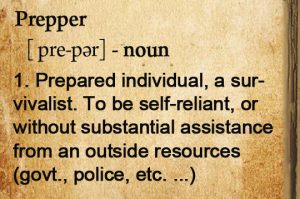Where and how to start your journey towards a more prepared house hold, Part 2
The way we started was relatively easy and inexpensive at first to get the basics in place. Having lived in southern Louisiana for 20+ years we quickly learned during Hurricane season you have got to have some sort of plan. Most of the storms for the 20 + years we lived in the region were near misses and we decided to bug out for two of the bad ones.
I recommended Knowledge as one of the first things you should try and gain in part 1, so in part 2 we will look at the basic categories of Items or Stuff I believe is needed for emergency preparations to keep yourself and family safe and secure.
- Water that’s clean and drinkable
- Shelter, could be your home, a tent, or proper clothing for your area.
- Food, canned goods, freezer stocked up, garden growing or freeze dried.
- Energy, be it heat to cook your food or warm your shelter or electricity for lights & radios.
- Security / Self Defense
- Reliable transportation
- Low or No Debt
- Trade Currency, i.e. cash (or Barter items), to acquire the things you need from others.
In most places in the United States we take having clean water available at our sinks for granted and are surprised when we hear an announcement on the radio that there is a boil water warning after a chemical spill in the local water source or some other contamination scare.
First on the list is store some water, FEMA recommends 1 gallon of water per person for three days. https://www.ready.gov/water
I am more of the thought that it should be a minimum of 1 gallon of water per day per person. Besides drinking water you need water for cooking, brushing your teeth and personal cleanliness and sanitation so one gallon is really not enough. The easiest way to store water is in plastic 1 and 2 liter soda or juice bottles. Don’t use milk jugs, over time they will break down and leak, don’t ask me how I know. Rinse them out with hot water and fill them up and put them in a climate controlled area of your house like a closet or storeroom. If you are on well water you could add a couple of drops of bleach but if you are on city water, it’s already in there. Then again bottled water in 12 to 16 ounce bottles is getting cheaper all the time at many stores and for simplicity sake you could stock up on cases of them. Either way get the first step is done and store some water. Over time, increase the storage as more bottles become available.
So and next on the list is water filtration and there are lots of options available. There are whole house water filter systems on the market and if you already have one or are thinking of investing in a system, do the research and find out exactly what they filter out. Outside of a whole house system, consider something like a Berkey filter for drinking and cooking water needs. They come in different sizes and prices so shop within your budget and get what you can afford. Less expensive still for smaller volumes of water there are water filter bottles and filter straws that will make water safe to drink.
Other options include catching rainwater with rain barrels, or purchasing food grade 55 gallon barrels and storing water in them. Drawback to these options is weight, you probably won’t be moving them around much and from the rain barrel you will definitely want to boil and or filter before drinking.
I recently saw another cool water storage product called a water brick, http://www.waterbrick.org/ and considered carrying their products in our online store but after surveying some friends the price point seemed a little high. That being said if that might be an option you would be interested in send me an email or comment below and if there is enough interest I’ll see what kind of group buy we might be able to put together.
Next up we will talk about shelter.
